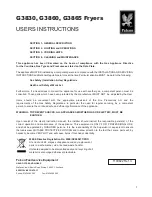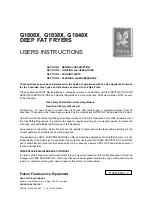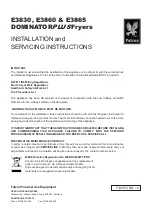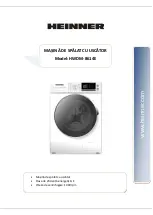
5
6
ˎ
,ü@
A
'
ˎ
@
I
cc+cc
\
4
.
u
a
a
ˎ
ˎ
a
3
#
Ê
a
9
²
a
ʋ
ʋ
ʋ
ʋ
ʋ
ʋ
ʋ
ʋ
ʋ
ʋ
ʋ
ʋ
ʋ
ʋ
ʋ
.
@
Information on laundry ...
Labelling of fabrics
Follow the manufacturer's care information.
(c
Drying at normal temperature.
'c
Dry at a low temperature
a
select
, @
°C
Aü
(Low Heat)
as well.
)c
Do not machine dry.
Do not tumble-dry the following fabrics:
– Airtight fabrics (e.g. rubber-coated fabrics).
– Delicate materials (silk, curtains made from synthetic material)
a
they may crease.
– Oil-stained laundry.
Drying tips
– To ensure a consistent result, sort the laundry by fabric type and drying programme.
– Close zips, hooks and eyes, and do up any buttons. Tie belts, apron strings etc. together.
– Do not overdry easy-care laundry
a
risk of creasing. Allow laundry to finish drying
in the air.
– Do not iron laundry immediately after drying, fold items up and leave for a while
a
the remaining moisture will then be distributed evenly.
– The drying result depends on the type of water used during washing.
a
Fine adjustment
of the drying result
a
Page 1/2
.
– Knitted fabrics (e.g. T-shirts, jerseys) often shrink slightly the first time they are tumble-dried.
a
Do not select the
+
+
Cupboard Dry Extra
programme.
– Starched laundry is not always suitable for dryers
a
starch leaves behind a coating that
adversely affects the drying operation.
– When washing laundry that is to be tumble-dried afterwards, dose the fabric softener
according to the manufacturer's instructions.
– With a small load, use the Timed Program.
Tips for Short spin/refreshing
– Use your dryer for unwrinkling and refreshing fabrics.
– Short spin cycle for reducing creasing.
– Refresh cycle for eliminating odours from fabrics.
Do not use Short spin/Refresh for the following fabrics:
– Wool, leather, fabrics with metal, wooden or plastic parts.
– Wax and oil jackets.
– Sort the laundry by colour and put on separate short spin/refresh cycles to prevent the
colours from bleeding.
– These programmes do not remove stains
a
stains must be treated and removed
beforehand.
– For best results, so that the laundry will have as few creases as possible, remove each item
immediately after the programme has finished and hang on a hanger to finish drying. Pull
clothes into shape if required.
Environmental protection / Energy-saving tips
– Before drying, spin the laundry thoroughly in the washing machine
a
the higher the spin
speed, the shorter the drying time will be (consumes less energy), also spin easy-care
laundry.
– Use the maximum recommended capacity, but do not exceed it
a
Page 7
, “Programme
overview”.
– Make sure the room is well ventilated during drying
.
– Clean the fluff filter after each drying cycle
a
page 4
.
– Keep the air cooler clean
a
page 6 “Cleaning and care”
.
– Keep the supply of cool air unobstructed
a
Do not cover or block the cooling grill.
Cleaning and care
Dryer housing, control panel, air cooler, moisture sensors
– Wipe with a soft, damp cloth.
– Do not use harsh cleaning agents and solvents.
– Remove detergent and cleaning agent residue immediately.
– During drying, water may collect between the door and seal. This does not affect your
dryer's functions in any way.
Clean the protective filter 5 - 6 times a year
or if
4
flashes after the fluff filter has been cleaned.
Air cooler / Protective filter
When cleaning, only remove the protective filter. Clean the air cooler
behind the protective filter once a year.
– Allow the dryer to cool.
– Residual water may leak out, so place an absorbent towel
underneath the maintenance door.
1.
Unlock the maintenance door.
2.
Open the maintenance door fully.
3.
Turn both locking levers towards each another.
4.
Pull out the protective filter/air cooler.
Do not damage the protective filter or air cooler.
Clean with warm water only.
Do not use any hard or sharp-edged objects.
5.
Clean the air cooler thoroughly.
Allow to drip dry.
6.
Clean the seals.
7.
Re-insert the protective filter/air cooler,
with the handle facing down.
8.
Turn back both locking levers.
9.
Close the maintenance door until the lock clicks into place.
Moisture sensors
The dryer is fitted with stainless steel moisture sensors. The sensors
measure the level of moisture in the laundry. After a long period of
operation, a fine layer of limescale may form on the sensors.
1.
Open the door and clean the moisture sensors with a damp sponge
which has a rough surface.
Do not use steel wool or abrasive materials.
Cover for steam nozzle
in the drum
After lengthy operation, limescale and fluff may accumulate on
the cover of the steam nozzle. Clean regularly:
1.
Open the door and remove the cover with a screw driver.
Clean the cover under running water.
2.
Push and click the protective cap back in place.
\
Only when switched off!
c
@c
c
Ê
|
c
÷
@
c
+
@
+
@
v
@c
a
@c
v
gü
a
\
É
a
+
+
|




























